20 Animals That Begin with the Letter I

Are you ready for an exciting safari through the animal alphabet? Delve into the fascinating realm of wildlife and discover a wide variety of creatures that share something in common: They’re all animals whose names begin with the letter ‘I’.
From majestic predators like the irbis to striking birds such as the ‘I’iwa, this list of 20 animals will take you on a journey through diversity. In this article, you’ll discover some of the most interesting species that inhabit our planet.
Animals that begin with the letter I and their characteristics
1. Green Iguana (Iguana iguana)

The green iguana is a species of lizard found in Central and South America. Its habitat extends from northern Mexico to northern Argentina. They prefer areas close to water, such as:
- Mangroves
- Coastal areas
- Tropical rainforests
.This is one of the largest lizards in America, with an average length of 6.5 feet and a weight of about 11 pounds.
Behavior:
- Herbivores: Green iguanas are mostly herbivores. They feed on leaves, flowers, fruits, and other vegetables.
- Territorial: Males are territorial and can be aggressive with other individuals during mating season.
- Thermoregulation: They spend time in the sun to raise their body temperature and then seek shelter in the shade or water to cool down.
- Swimming: These reptiles are excellent swimmers and can dive to forage for food or escape predators. In fact, they can remain underwater for long periods of time.
The iguana may shed its tail if it becomes trapped. This limb will grow back without any apparent damage.
2. Impala (Aepyceros melampus)
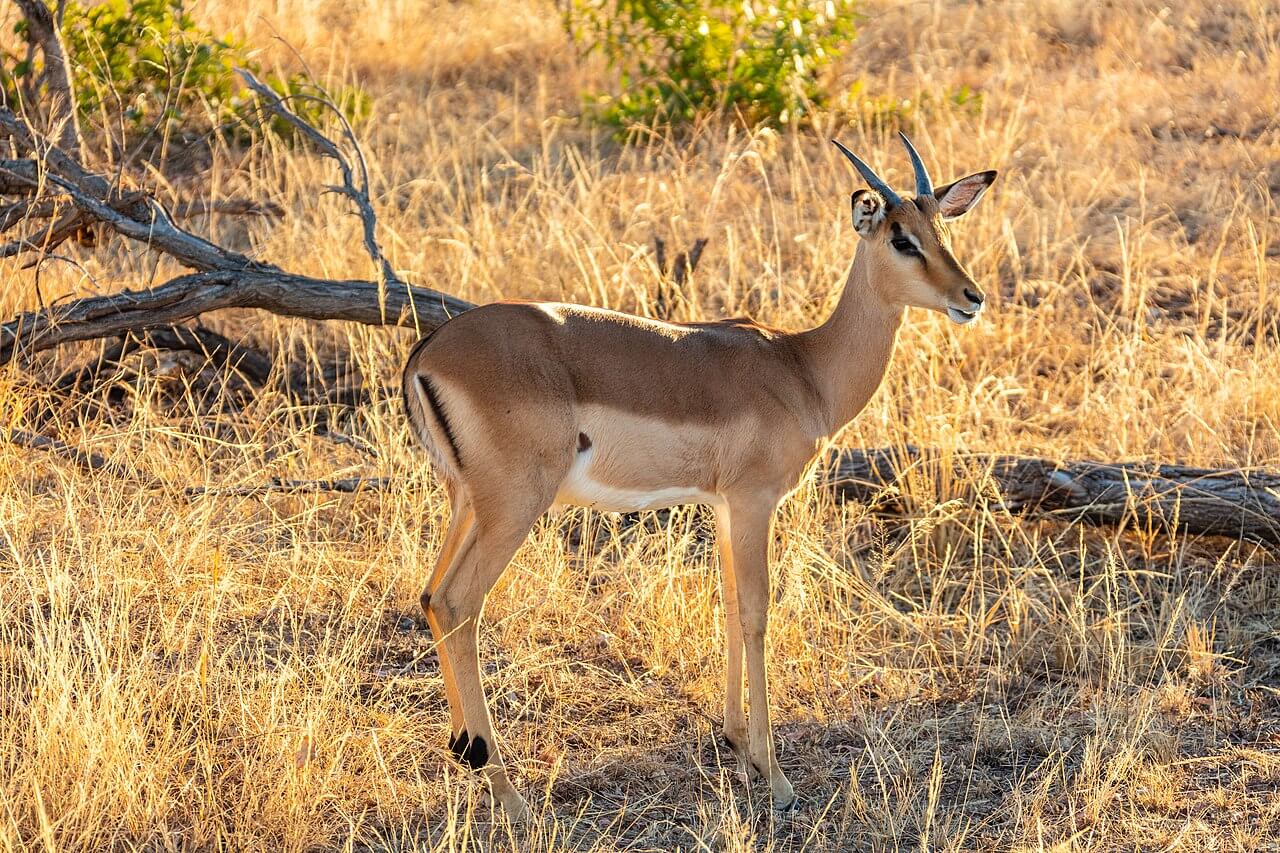
The Impala is an African antelope found mainly in eastern and southern Africa. Its habitat covers a wide variety of areas, such as the following:
- Savannahs
- Plains
- Riparian forests
- Scrublands
.Their adaptability to different environments is one of the reasons why impalas have a wide distribution in Africa.
Physical characteristics:
- Size: Impalas are medium-sized animals with a body length ranging from 47 to 63 inches. They reach a shoulder height of about 30 to 37 inches.
- Weight: They weigh between 88 and 165 pounds.
- Coloration: They have a light brown coat with spots on the back and thigh, which can vary in intensity depending on the region. Males are usually a little darker than females.
- Horns: Males have elegant lyre-shaped horns that can reach lengths of up to 35 inches.
Behavior:
- Social habits: Impalas are social animals and often congregate in groups called “harems” that are led by a dominant male. These groups can vary in size from a few individuals to several hundred.
- Diet: They’re herbivores, and their diet is dominated by grass, although they may also consume leaves, shoots, and fruits. Their diet varies according to seasonal food availability.
- Predators: Impalas are an important prey for many African predators such as lions, leopards, cheetahs, and hyenas. Their ability to jump and run at high speed helps them evade predators.
3. African Sacred Ibis (Threskiornis aethiopicus)

The African sacred ibis is a waterbird found in various regions of the world. Its natural habitat ranges from Africa (except in the Sahara) to southern Asia and Australia. It can be found in a variety of aquatic habitats, including the following:
- Rivers
- Lakes
- Ponds
- Wetlands
Physical characteristics:
- Size: African sacred ibises have a body length ranging from 27 to 32 inches.
- Coloration: They have a plumage dominated by white and black on the wings, which often resemble a saddle. The head and neck are bare and black, with a small bare white facial area.
- Beak: Long and curved. This shape makes it very useful for foraging in water and mud.
Behavior:
- Diet: African sacred ibises are omnivorous birds, although their main diet consists of aquatic insects, crustaceans, mollusks, and other small organisms they find in their environment. They may also consume small vertebrates, seeds, and vegetation.
- Social behavior: They tend to live in social groups and are gregarious birds.
The sacred ibis has cultural significance in some societies and religions. In ancient Egypt, it was considered a symbol of Thoth, the god of writing and wisdom.
4. Alpine ibex (Capra ibex)
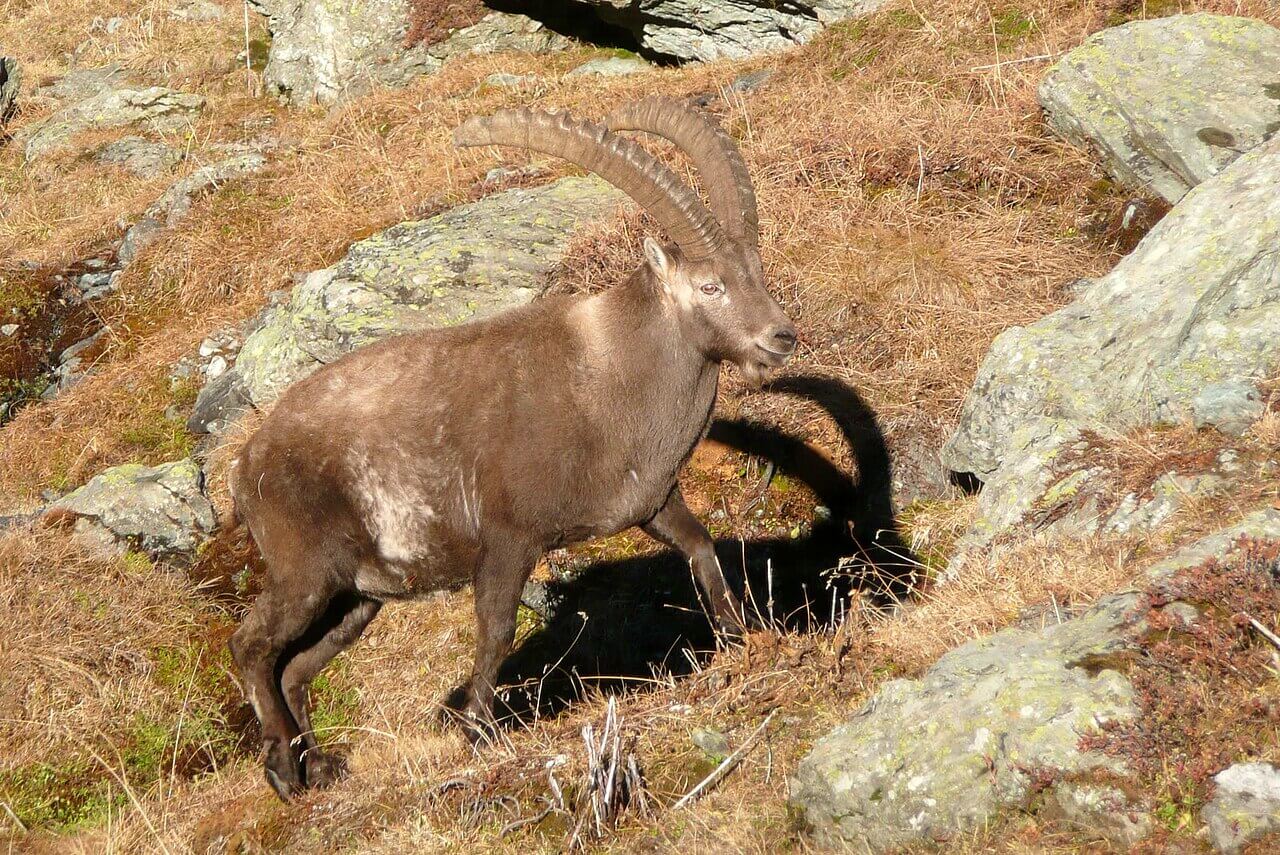
We continue this tour of animal names that start with the letter I with the alpine ibex, which inhabits alpine meadow regions and is found above the forest edge at altitudes ranging from 5250 to 10,500 meters.
Alpine ibexes are known for their exceptional agility on rocky terrain. This ability is matched only by other members of their genus. During the changing seasons, ibexes descend to lower altitudes in winter.
Physical characteristics:
- Size: The size of ibexes varies by species. However, in general, they have robust bodies and short legs, adapted for moving on steep terrain. They can measure between 3.3 and 5 feet long and have a shoulder height of 28 to 40 inches.
- Horns: Males have large, curved horns that can reach impressive lengths. They’re often used for combat during the mating season.
- Coloration: Generally, their fur is brown to gray, which helps them camouflage in their mountainous environment.
Behavior:
- Diurnal habits: Ibexes are diurnal animals, meaning they tend to be most active during the day.
- Herbivores: They feed on grass, leaves, shrubs, and other plants found on mountain slopes.
- Social habits: They tend to live in groups, especially during the winter season when foraging is more difficult. Groups can vary in size from a few individuals to dozens.
5. Wattled Ibis (Bostrychia carunculata)
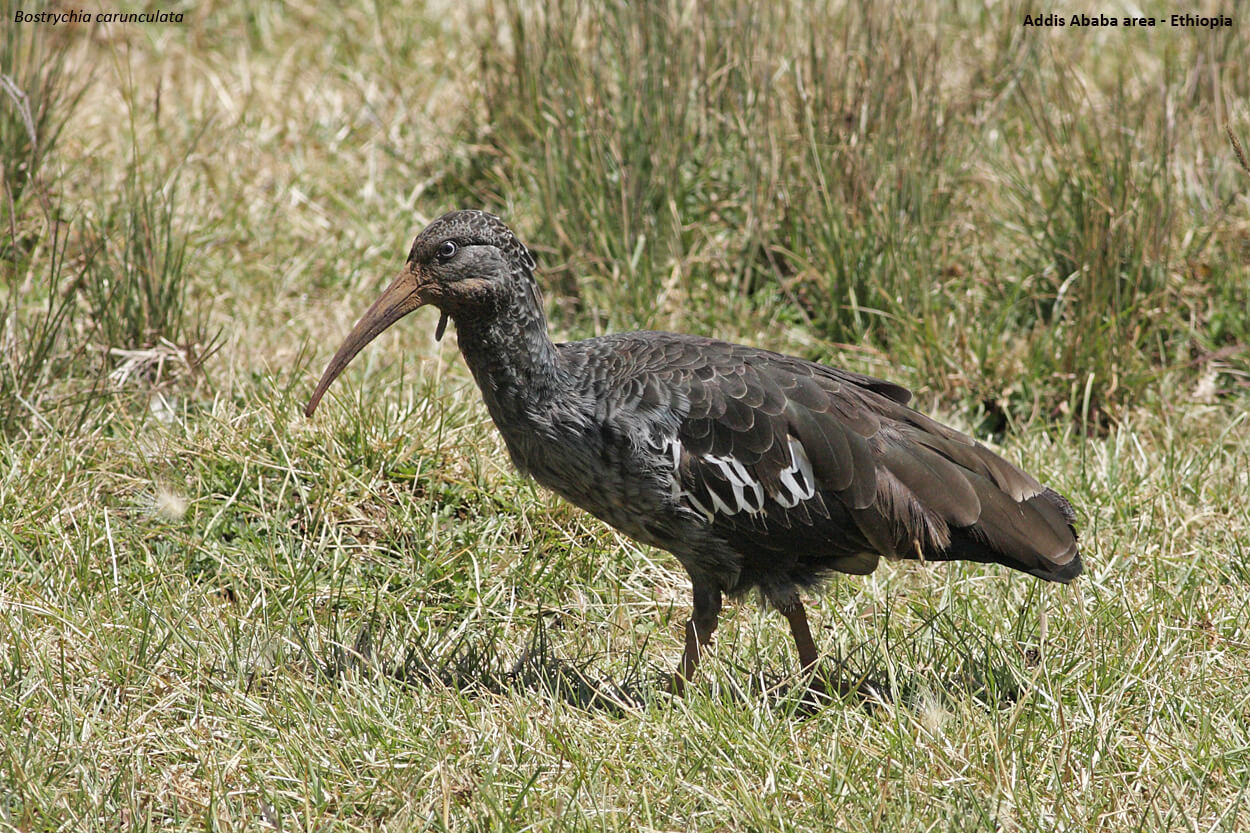
The wattled ibis is endemic to Africa. It’s found in the mountainous regions of Ethiopia and Eritrea. It can be seen near watercourses such as lakes, swamps, and wetlands in these highlands, where it can find food and shelter:
Physical characteristics:
- Size: Wattled ibises are medium-sized birds, with a body length ranging from 20 to 24 inches.
- Coloration: They have a fairly dark brown plumage, with white spots on the wings that become visible when in flight. Their beak is long and curved downwards. Beneath it, they have a small beard.
Behavior:
- Diet: Wattled ibises are omnivorous and feed on a varied diet that includes aquatic insects, such as crustaceans, mollusks, small vertebrates, amphibians, fish, and plant matter.
- Social habits: They tend to be gregarious birds and group together in colonies during the breeding season. During this season, they perform nuptial displays, which include movements and vocalizations to attract mates.
6. ‘I’iwi (Drepanis coccinea)
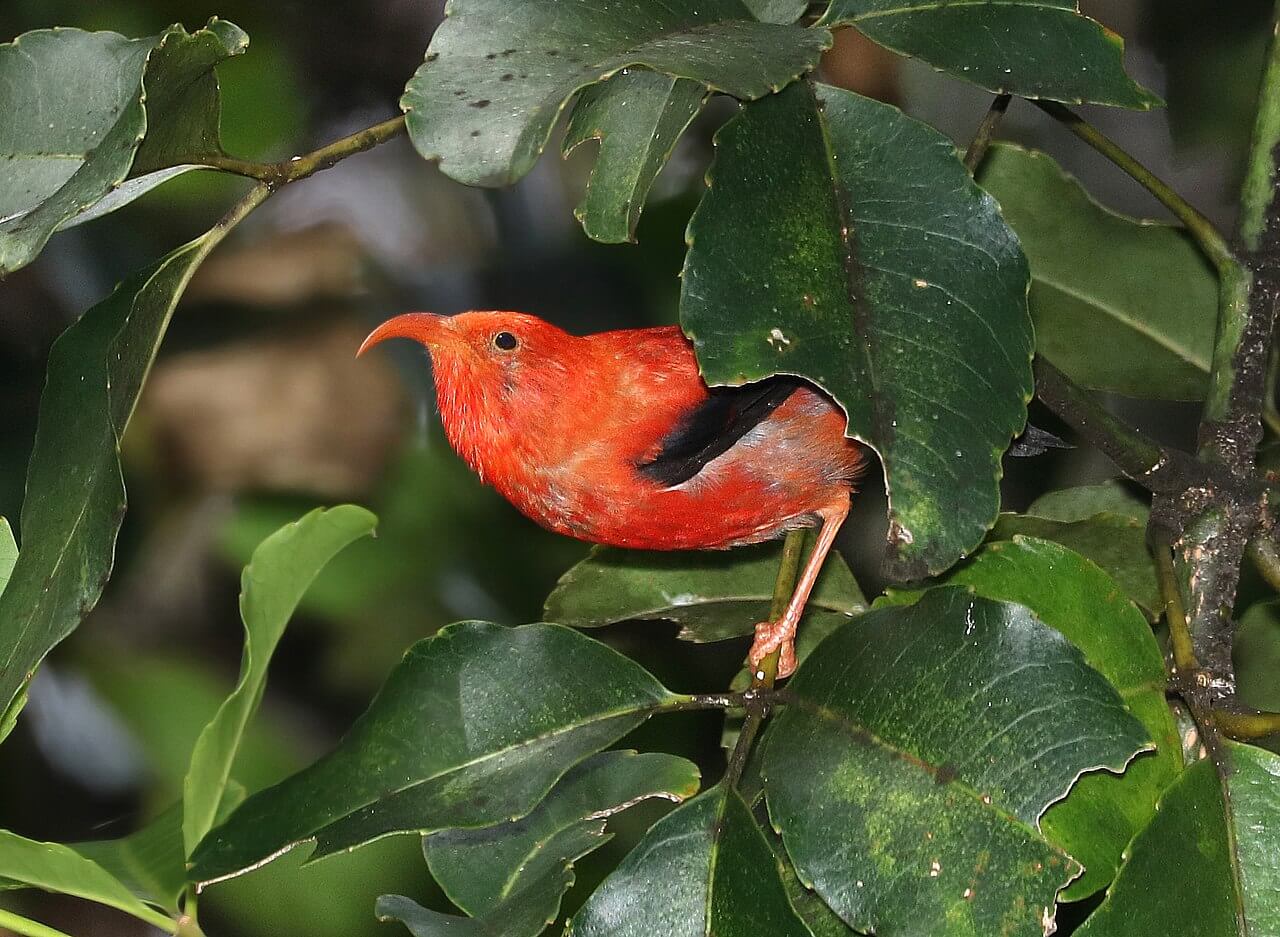
The ‘i’iwi, also known as the scarlet honeycreeper is a bird endemic to Hawaii and belongs to the family Fringilidae.
Physical characteristics:
- Size: It’s a medium-sized species, with a length of about 6 inches.
- Coloration: The most distinctive feature of the ‘i’iwi is its vibrant deep crimson plumage, which gives it its common name. It has black wings with white spots and a long, curved, orange bill, which allows it to access flower nectar. Its legs are gray.
This bird is the protagonist of legends and songs in Hawaiian culture. Its presence in the forest is an indicator of ecosystem health, and its decline has led to an increased focus on forest conservation.
7. Indri (Indri indri)
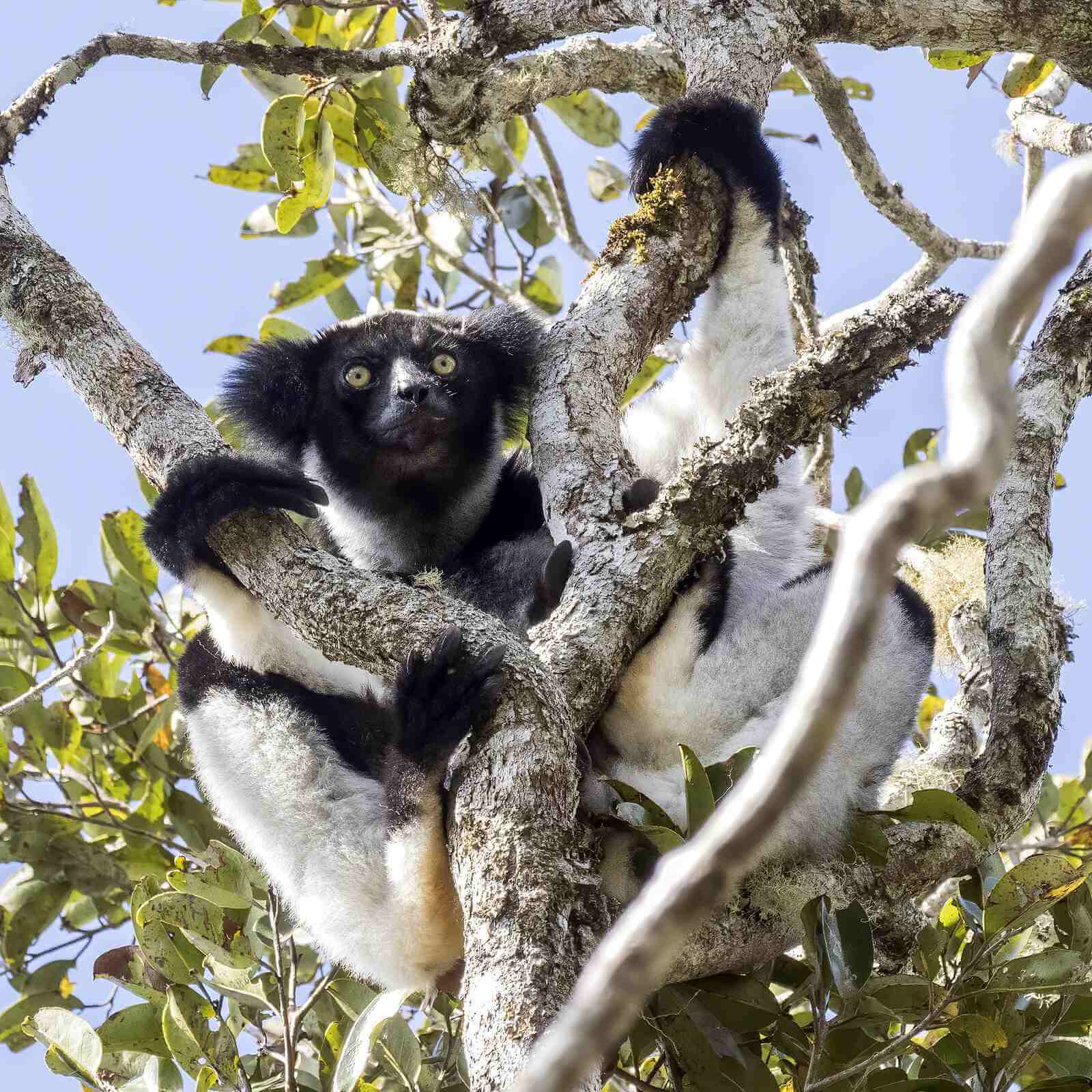
According to Animal Diversity Web, the indri is a primate belonging to the Indriidae family and is known to be the largest lemur found in Madagascar.
Physical characteristics:
- Size: Adult indris can reach 25 to 28 inches in length. They weigh between 13 and 22 pounds.
- Coat: Their coat is dense and soft, black or brown, with white spots or patches on specific areas of the face and limbs. They have amber to orange eyes and large rounded ears.
- Tail: Unlike other lemurs, indris have a very short tail that, in many cases, isn’t even visible.
Their striking song and social behavior make them stand out in the primate world.
8. Irbis (Panthera uncia)
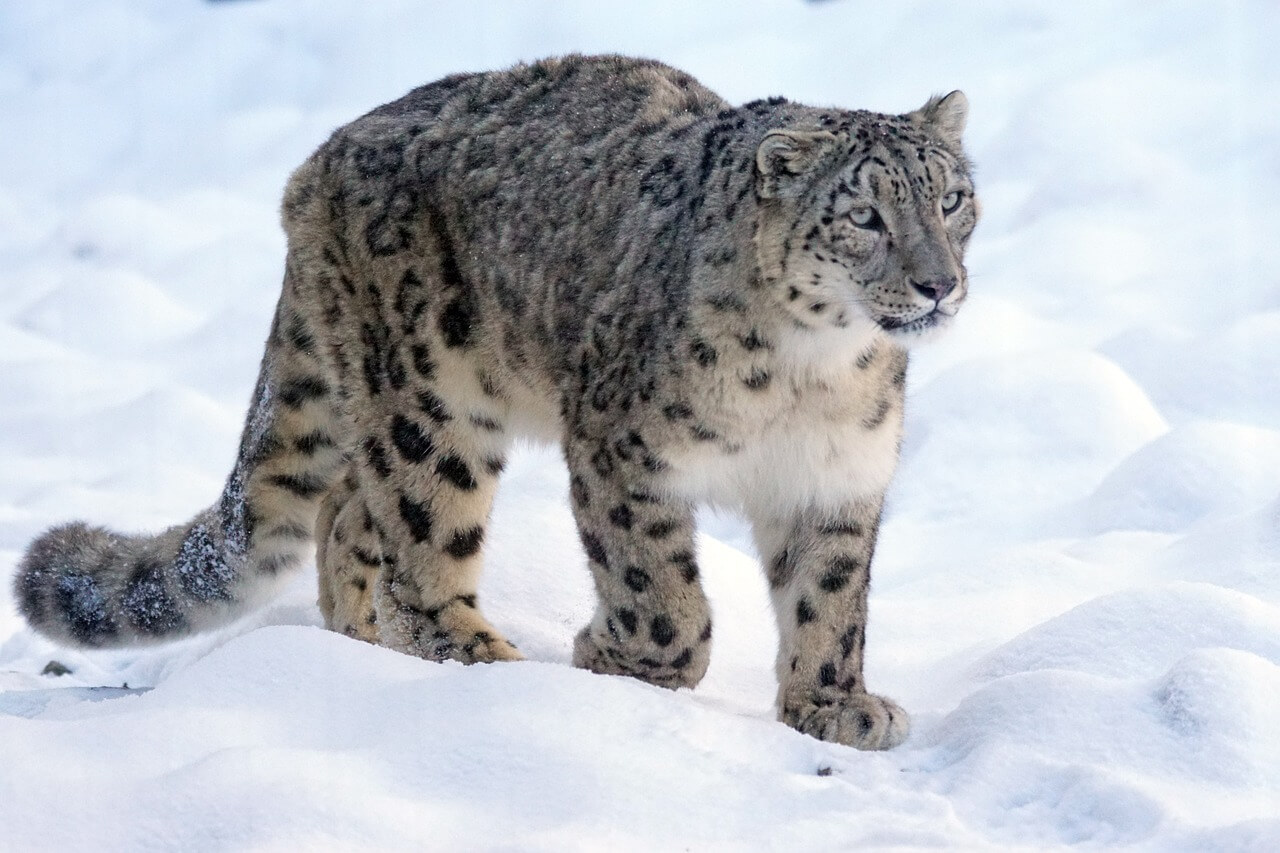
The irbis, known in the West as the snow leopard (Panthera uncia), is a large feline that lives in the mountainous regions of Central Asia and parts of South Asia.
Physical characteristics:
- Size: Snow leopards are medium to large felines. Males are usually larger than females, with a body length ranging from 30 to 51 inches, plus a tail that can measure between 32 and 41 inches. Their height at the shoulder is about 20 inches.
- Coat: Thick and long in order to provide insulation in its cold habitat. Its coat is grayish-yellow or cream with black spots. These are very distinctive and act as camouflage in its rocky and snowy environment.
- Cold adaptations: The snow leopard has adaptations for living in cold climates. It has small, rounded ears, which minimize heat loss, as well as a long, furry tail to keep warm.
- Paws and tail: Their paws are wide and thickly padded, allowing them to move quietly in the snow. The long tail is also used for balance while hunting in mountainous terrain.
9. Rainbow starfrontlet or Inca arcoiris (Coeligena iris)

The Inca arcoiris, known in English as the rainbow starfrontlet, is a species of hummingbird that inhabits the mountainous regions of South America, particularly in the Andes of Colombia, Ecuador, and Peru. It’s known for its colorful plumage and beauty.
Physical characteristics:
- Size: The rainbow starfrontlet is medium-sized, with a length of about 4 to 4.75 inches.
- Plumage: It’s colorful and bright, which gives it its common name. The head and neck are a brilliant shade of purple, while the back and wings are dark green. The chest and underside are iridescent blue. Its tail is long and forked, with green feathers and a purple hue at the tips.
Hummingbirds, including the Inca arcoiris, are known for their agile and rapid flight. They have the ability to hover in the air and perform acrobatic flights to feed on flower nectar.
10. Irará (Eira barbara)
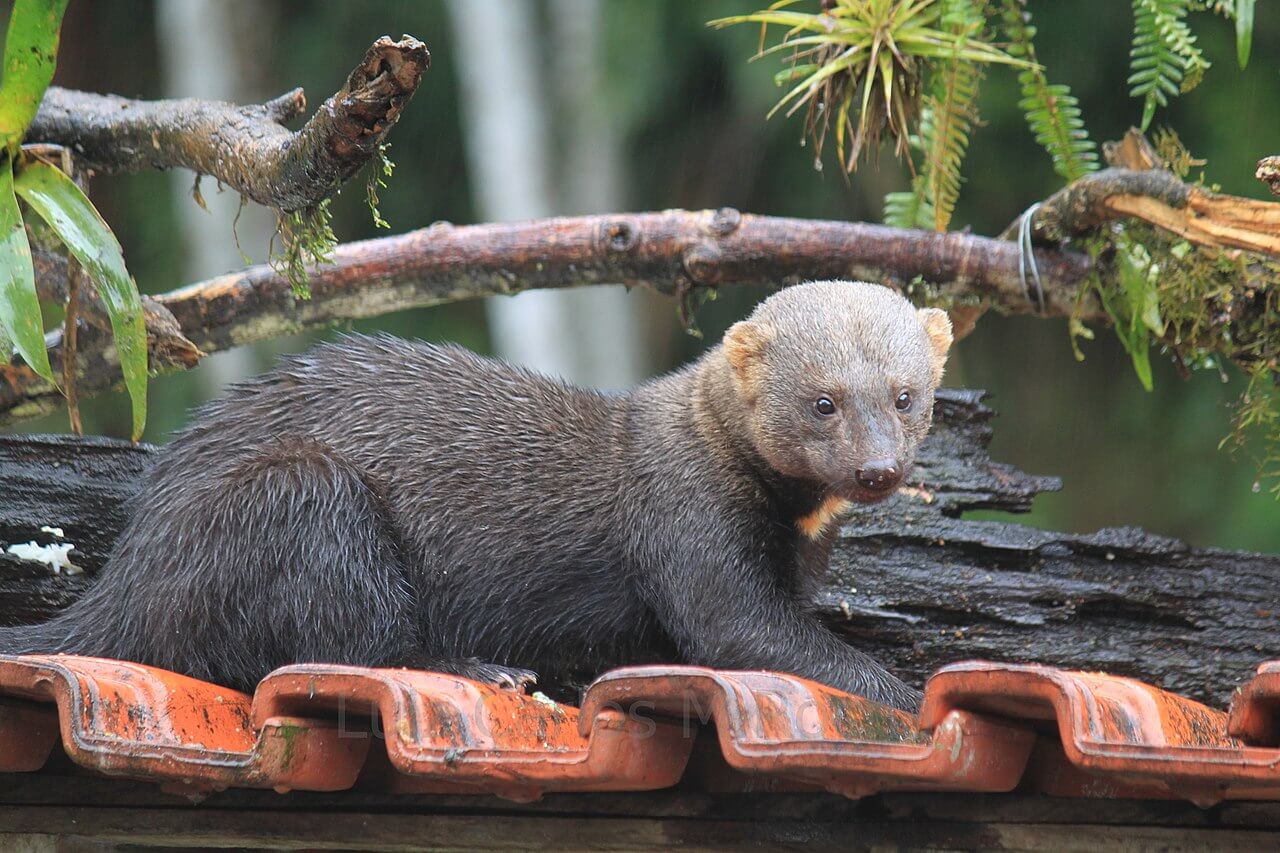
The irará, also known as the tayra, is a carnivorous mammal belonging to the family Procyonidae, which includes raccoons and coatis.
Physical characteristics:
- Size: Irarás are medium to large in size, with a body length ranging from 24 to 39 inches, not including the tail. The tail is long and can measure 18 to 30 inches.
- Coat: Rough, thick, and brown or grayish in color. They also usually have a yellowish-orange spot on the throat.
- Tail: Prehensile, which means that they can grasp objects with it, which helps them to climb trees and move nimbly in their habitat.
Habitat and distribution:
These mammals are native to Central and South America. They’re found in a wide range of habitats, including the following:
- Savanna
- Forests
- Mangroves
- Rainforests
Their geographic distribution includes an extensive list of countries:
- Peru
- Belize
- Brazil
- Mexico
- Guyana
- Panama
- Ecuador
- Suriname
- Colombia
- Honduras
- Nicaragua
- Venezuela
- Costa Rica
- Guatemala
- French Guiana
11. Moorish idol (Zancluscornutus)
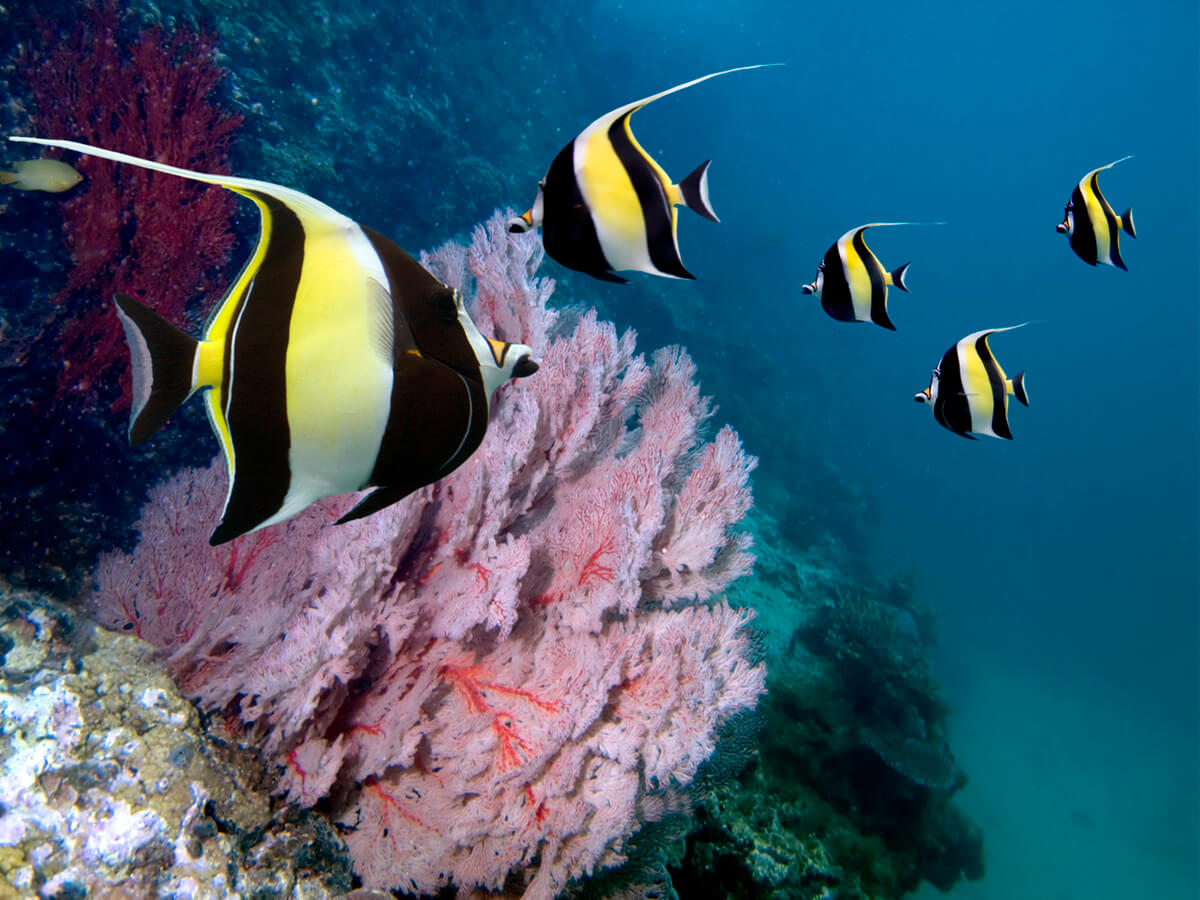
The Moorish idol is a species of marine fish belonging to the family Zanclidae. It’s known for its unusual appearance and distinctive profile, which distinguishes it in the coral reefs of the Indian and Pacific oceans.
Physical characteristics:
- Shape and color: This fish has a flattened, elongated body, with a large head and small mouth. Its coloration is impressive, with a bright yellow body and vertical black stripes. A distinctive feature is its long, slender snout that protrudes forward, hence its common name.
- Dorsal fin: It’s very tall and striking. It extends upwards from its head and then slopes backward.
- Size: Moorish idols can grow up to between 8 and 9.5 inches in length.
12. Ifrita (Ifrita kowaldi)

The ifrita is a species of bird in the family Ifritidae found in the forests of New Guinea.
Physical characteristics:
- Size: They’re small birds, with a body length of 6 to 6.75 inches.
- Plumage: They have contrasting colors. Their breast is yellowish-cream in color, while the wings are brown.
- Head: They have a blue and black crown.
Ifrites are venomous birds, which spend most of their time foraging for insects and other invertebrates.
13. Inambú (Nothura maculosa)
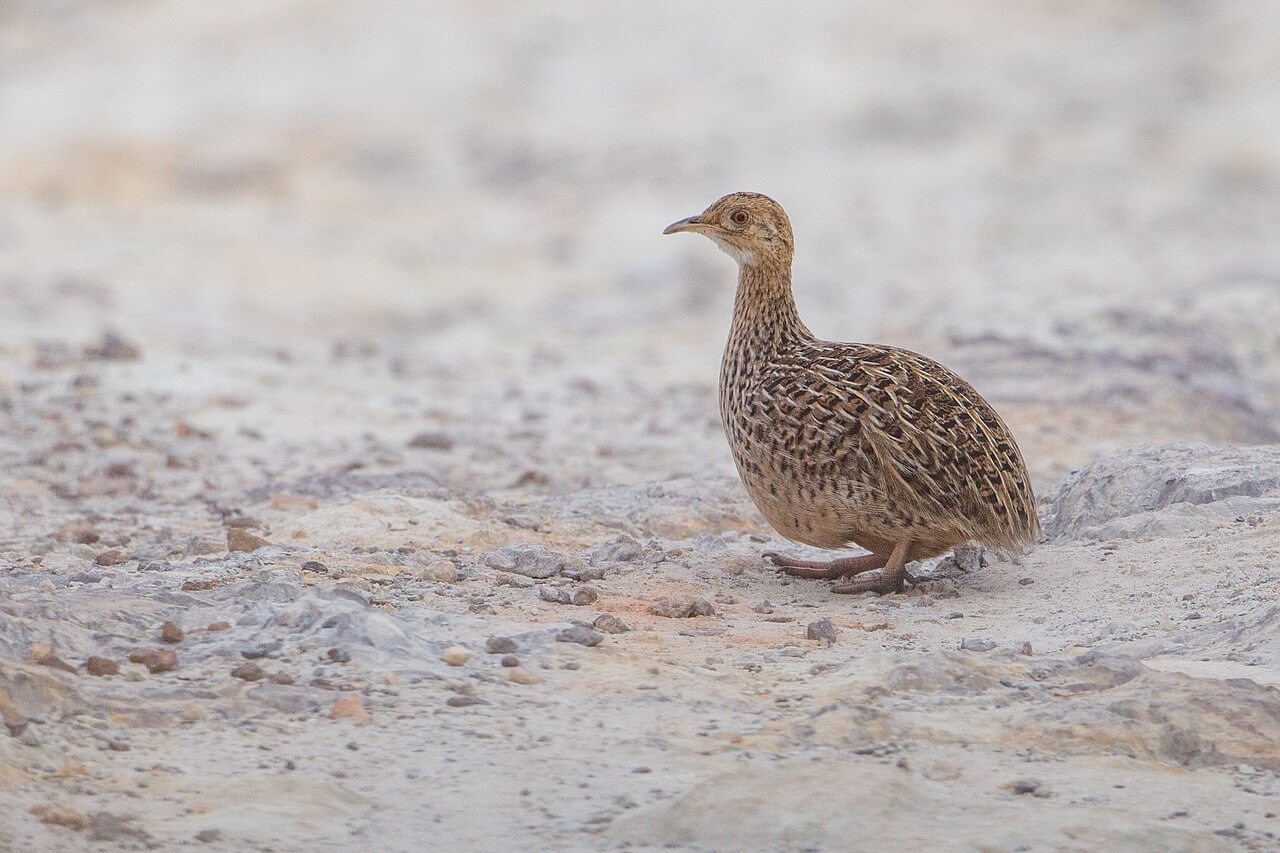
The inambú is a species of bird belonging to the Tinamidae family, which includes the tinamous birds. These birds are found in South America, known in English as spotted nothuras, and are known for their small to medium size, terrestrial appearance, and limited flight capabilities.
Physical characteristics:
- Size: Small to medium, with a body length ranging from approximately 8 to 11 inches.
- Plumage: Brown or grayish color predominates, which provides effective camouflage in their terrestrial habitat. These birds have a mottled or striped plumage, which helps to disguise them among the vegetation.
- Legs: They’re sturdy and strong, adapted for walking and running on the ground.
Inambús move stealthily in search of food. They’re shy and secretive birds, which often makes them difficult to observe.
14. Grey-winged Inca finch (Incaspiza ortizi)
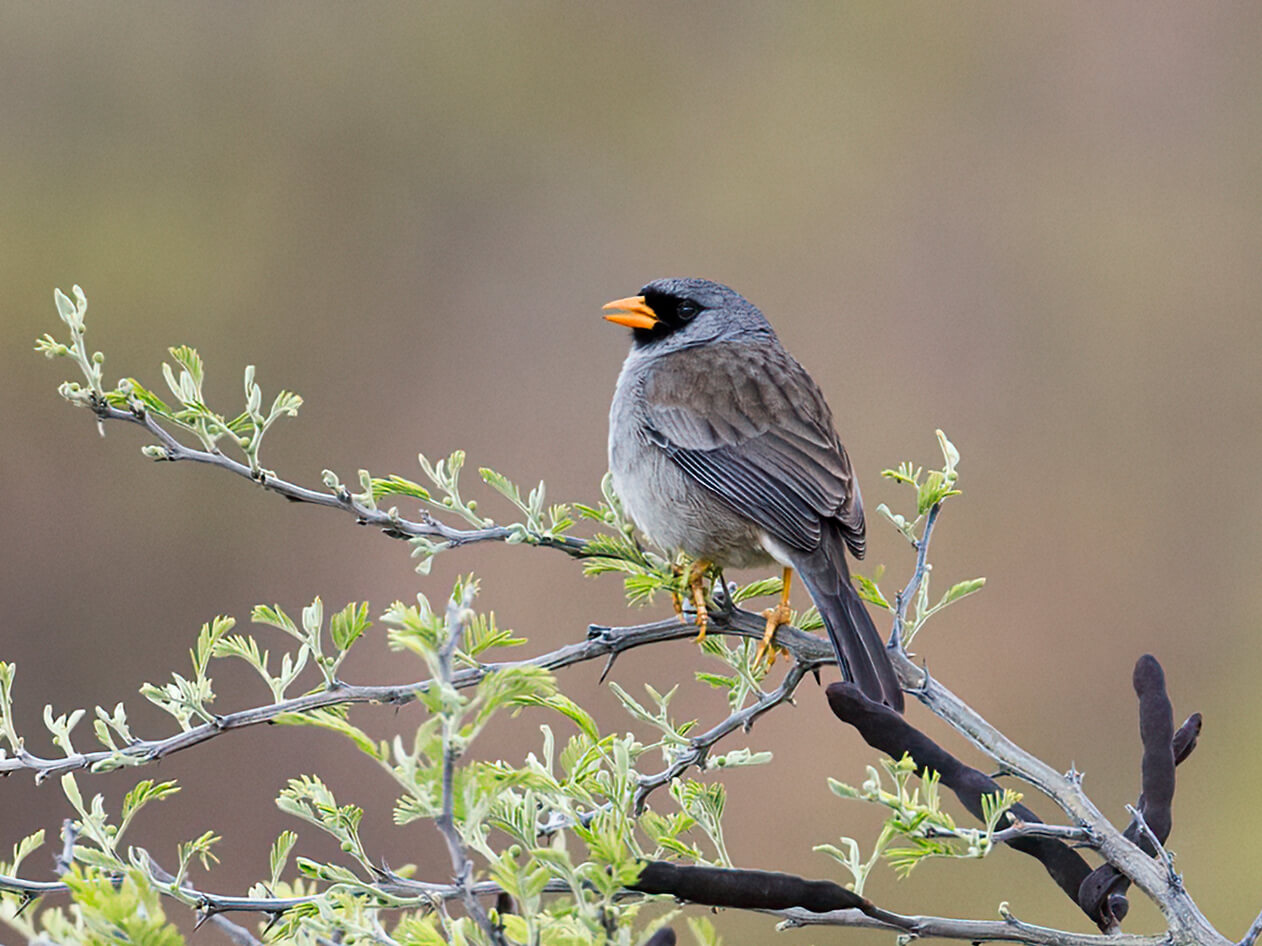
The gray-winged Inca finch belongs to the genus Incaspiza. This passerine bird of the family Thraupidae is endemic to Peru and is found in the Andes.
Physical characteristics:
- Size: These are small to medium-sized birds, with a body length that generally ranges between 6 and 8 inches.
- Plumage: Gray and brown predominates, which allows them to camouflage themselves in their mountainous environment. Around their beaks, they exhibit black plumage.
- Beak and legs: They have yellow pointed beaks and legs adapted for life in mountainous areas.
Their diet is dominated by seeds and small invertebrates found in their mountainous environment. Their beaks allow them to extract seeds from plants and flowers.
15. Common Iora (Aegithina tiphia)

The common iora is a species of passerine bird, belonging to the family Aegithinidae. This species is found in South Asia and Southeast Asia.
Physical characteristics:
- Size: It’s a small bird, with a body length ranging from 5 to 6 inches.
- Plumage: It’s colorful and often exhibits sexual dimorphism, meaning that males and females have slightly different colors. Males tend to have bright green plumage on top and yellow underneath, while females tend to be duller, with softer shades of green. In addition, coloration varies among subspecies.
- Beak: They have a slender, pointed beak, adapted for feeding on insects and other invertebrates.
They’re often seen in small groups or flocks, which provides protection from predators and allows them to forage more efficiently.
16. Ipequí or Sungrebe (Heliornis fulica)
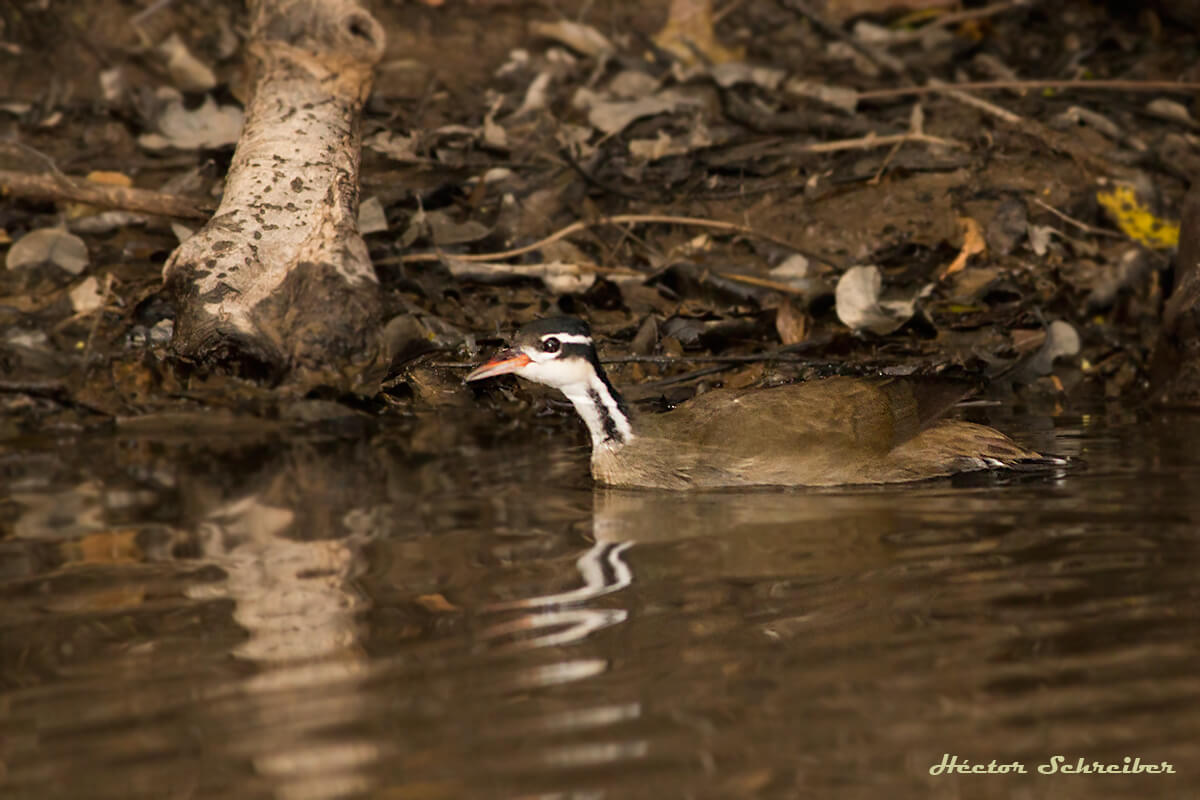
Known locally as the ipequí, the sungrebe is a species of aquatic bird belonging to the family Heliornithidae. This family includes birds known as “hammerbirds,” due to the shape of their beaks. The ipequi is distinguished by its unusual appearance and semi-aquatic lifestyle.
Physical characteristics:
- Size: They’re small birds with a body length ranging between approximately 10 and 11 inches.
- Plumage: They have a plumage of variable coloration depending on age and geographic region. Adult individuals usually have dark brown plumage on the upper part and lighter on the lower part. Juveniles may have a more mottled plumage.
- Beak: They have a long, slender beak with a distinctive hammer shape, which they use for feeding and catching prey underwater.
Its geographic distribution covers several countries in South America, including the following:
- Peru
- Brazil
- Bolivia
- Ecuador
- Paraguay
- Colombia
- Venezuela
17. Irena or Asian fairy-bluebird (Irena puella)
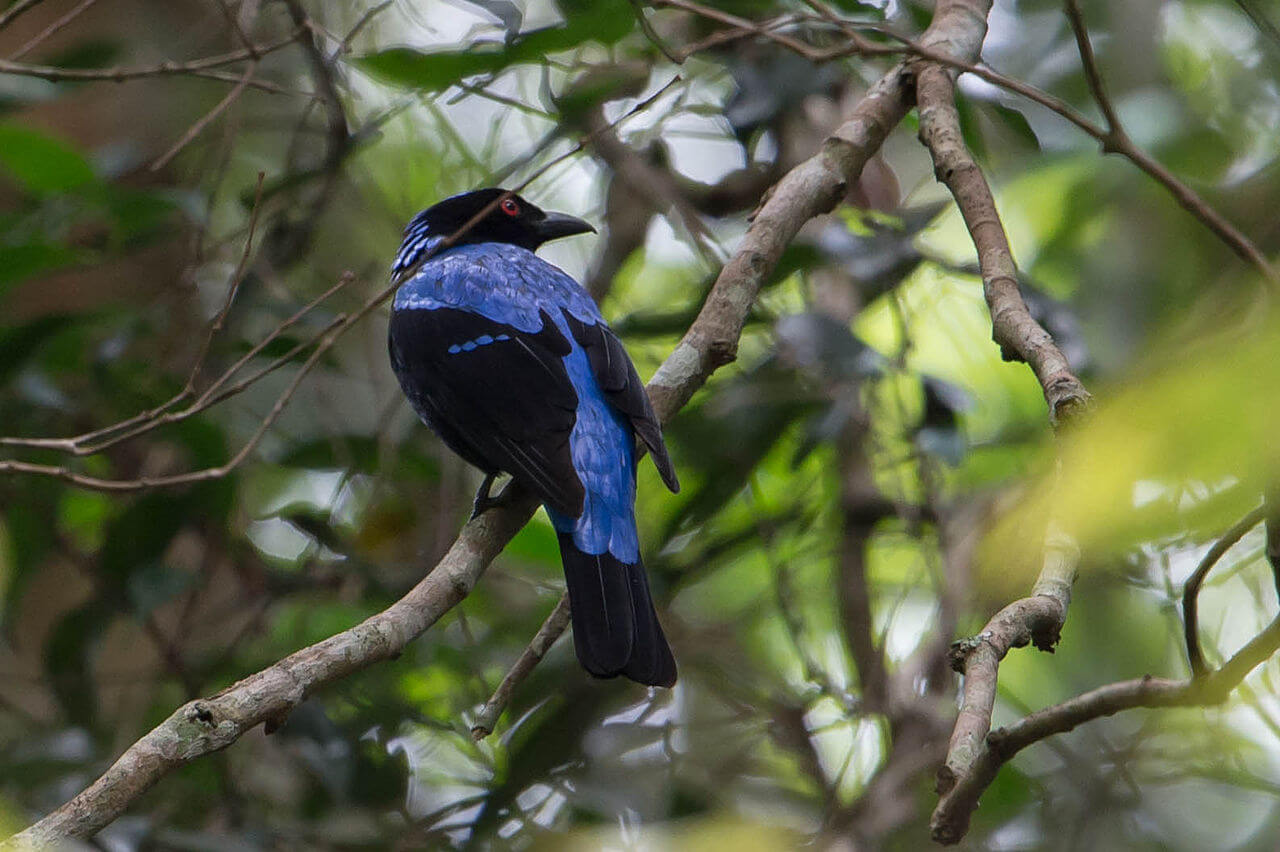
The genus Irena includes several species of passerine birds found in Southeast Asia and parts of tropical Asia. The most well-known species in this genus is the Asian fairy-bluebird, a graceful and colorful bird.
Physical characteristics:
- Size: Asian fairy-bluebirds are medium-sized birds, with a body length ranging from 6 to 7 inches.
- Plumage: They have vibrant colors, with shades that vary according to the species. In the case of Irena puella, males are electric blue and females are turquoise. This makes them quite striking visually.
- Beak: It’s long, slender and slightly curved at the tip. It’s adapted to feed on nectar and catch insects in flight.
18. Irukandji (Carukia barnesi)
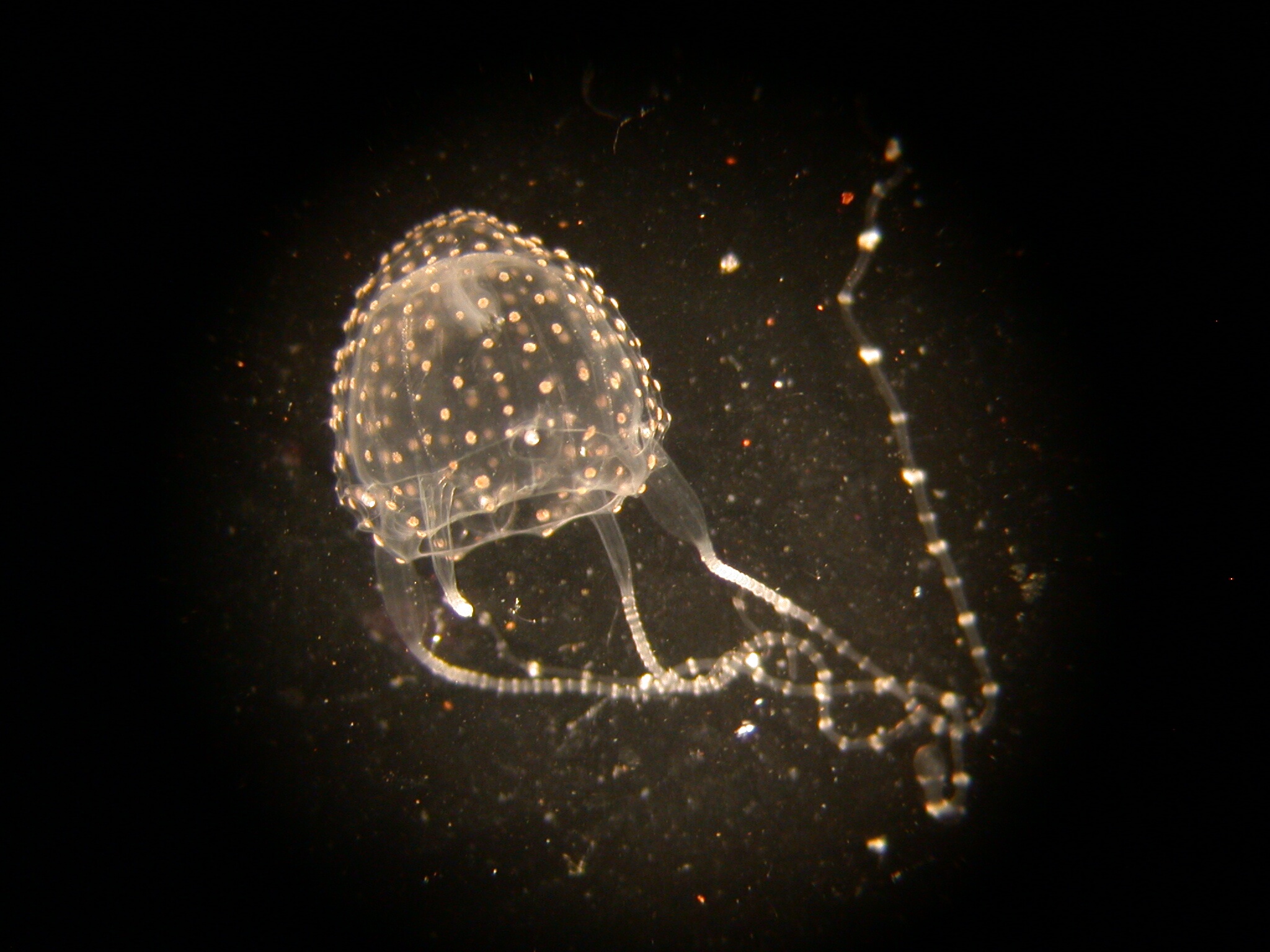
The irukandji is a small venomous jellyfish found in the waters of the Indian and Pacific Oceans, particularly off the coast of Australia. This jellyfish is famous for its rather painful sting and its potentially fatal toxic effects.
It’s a small jellyfish, usually about the size of a fingernail. Its bell is transparent and its tentacles are long and thin.
19. Ipacaá or giant wood rail (Aramides ypecaha)
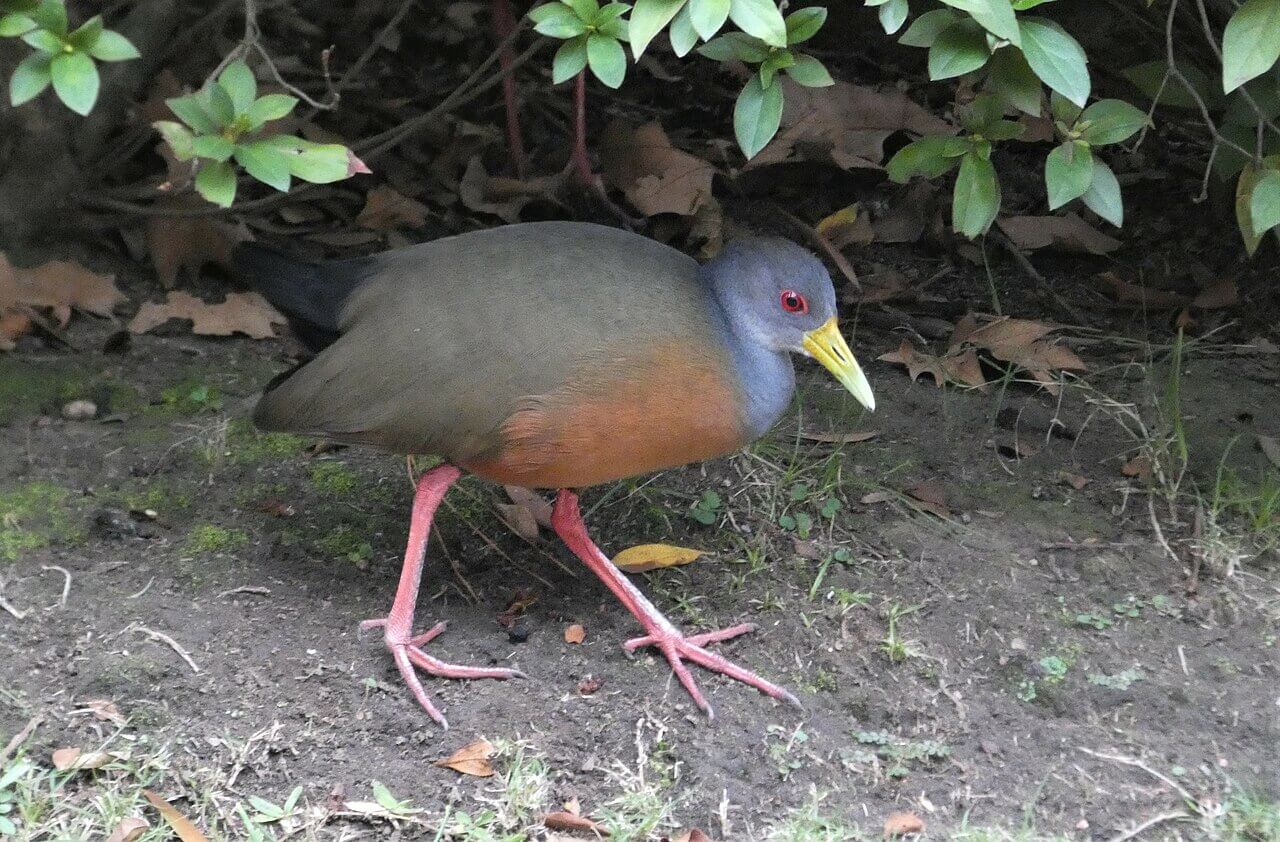
The giant wood rail is a species of bird of the family Rallidae. It’s found mainly in South American countries such as Argentina, Brazil, Paraguay, and Uruguay, where it’s known as the ipacaá.
Physical characteristics:
- Size: It’s a medium-sized bird, with a body length ranging between 12 and 16 inches.
- Plumage: Predominantly brown and gray. It has a robust yellow beak, and its legs are pink.
20. Green Iora (Aegithina viridissima)
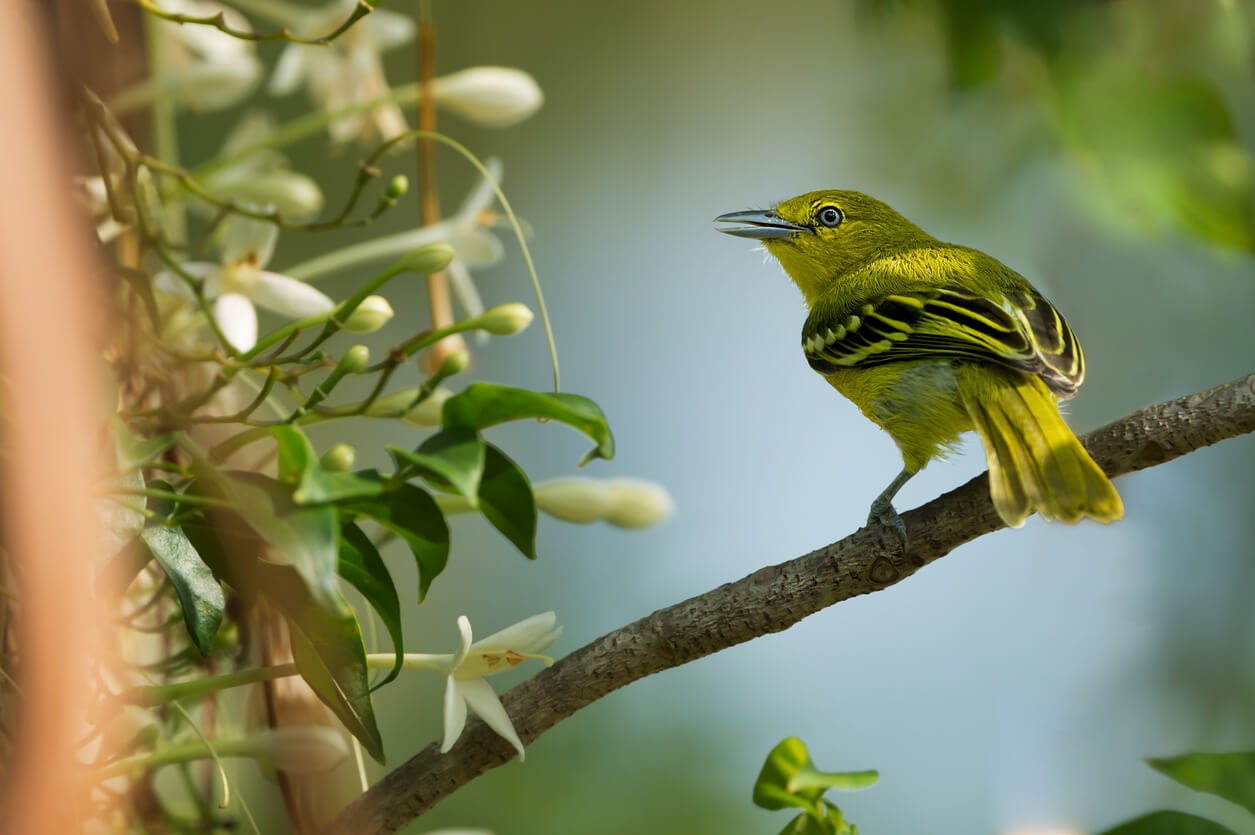
With the green iora, we conclude this compilation of animals beginning with the letter ‘I’. Like the common iora, it belongs to the genus Aegithina. Therefore, both share some similarities in their appearance and behavior. However, they also have differences that allow them to be identified.
1. Plumage color:
The common iora has a plumage that’s usually a combination of bright green and yellow in males. In contrast, females are duller, with an olive hue on the back and a white or pale yellow abdomen.
On the other hand, the green iora, as its name suggests, has a plumage that’s predominantly green in males, with a brighter green head, back, and tail. Females, in contrast, exhibit more olive green.
2. Size and morphology:
Both species are small birds, but the green iora tends to be smaller, on average, with a body length of about 4 to 6 inches. In comparison, the common iora can have a body length of about 4.75 to 6 inches.
3. Geographic distribution:
The common iora has a geographic distribution that covers a wide area in South Asia and Southeast Asia, including India, Sri Lanka, Burma, Thailand, Malaysia, and Indonesia. In contrast, the green iora is found in more specific parts of tropical Asia, such as Indonesia, the Philippines, Thailand, and adjacent regions.
4. Behavior and song:
Both species share an active behavior and are known for their agility in searching for insects among leaves and branches. Their songs vary, with characteristic melodies and trills that can help distinguish them by ear. The common iora emits a more varied and complex song compared to the song of the green iora.
5. Habitat:
Both birds live in a variety of habitats, including forests, gardens, shrubs, and dense vegetation:
The green iora tends to be more associated with wetter habitats, such as rainforests and riparian areas.
Discover the diversity of animals
As you can see after taking this tour of animals beginning with the letter “I”, each letter of the alphabet offers us a world of creatures to discover. Throughout this journey, we’ve discovered the importance of biodiversity. May we never forget that each animal species, from the imposing ibis to the enigmatic iguana, plays a crucial role in the balance of our ecosystems and that we must contribute to their conservation.
Are you ready for an exciting safari through the animal alphabet? Delve into the fascinating realm of wildlife and discover a wide variety of creatures that share something in common: They’re all animals whose names begin with the letter ‘I’.
From majestic predators like the irbis to striking birds such as the ‘I’iwa, this list of 20 animals will take you on a journey through diversity. In this article, you’ll discover some of the most interesting species that inhabit our planet.
Animals that begin with the letter I and their characteristics
1. Green Iguana (Iguana iguana)

The green iguana is a species of lizard found in Central and South America. Its habitat extends from northern Mexico to northern Argentina. They prefer areas close to water, such as:
- Mangroves
- Coastal areas
- Tropical rainforests
.This is one of the largest lizards in America, with an average length of 6.5 feet and a weight of about 11 pounds.
Behavior:
- Herbivores: Green iguanas are mostly herbivores. They feed on leaves, flowers, fruits, and other vegetables.
- Territorial: Males are territorial and can be aggressive with other individuals during mating season.
- Thermoregulation: They spend time in the sun to raise their body temperature and then seek shelter in the shade or water to cool down.
- Swimming: These reptiles are excellent swimmers and can dive to forage for food or escape predators. In fact, they can remain underwater for long periods of time.
The iguana may shed its tail if it becomes trapped. This limb will grow back without any apparent damage.
2. Impala (Aepyceros melampus)

The Impala is an African antelope found mainly in eastern and southern Africa. Its habitat covers a wide variety of areas, such as the following:
- Savannahs
- Plains
- Riparian forests
- Scrublands
.Their adaptability to different environments is one of the reasons why impalas have a wide distribution in Africa.
Physical characteristics:
- Size: Impalas are medium-sized animals with a body length ranging from 47 to 63 inches. They reach a shoulder height of about 30 to 37 inches.
- Weight: They weigh between 88 and 165 pounds.
- Coloration: They have a light brown coat with spots on the back and thigh, which can vary in intensity depending on the region. Males are usually a little darker than females.
- Horns: Males have elegant lyre-shaped horns that can reach lengths of up to 35 inches.
Behavior:
- Social habits: Impalas are social animals and often congregate in groups called “harems” that are led by a dominant male. These groups can vary in size from a few individuals to several hundred.
- Diet: They’re herbivores, and their diet is dominated by grass, although they may also consume leaves, shoots, and fruits. Their diet varies according to seasonal food availability.
- Predators: Impalas are an important prey for many African predators such as lions, leopards, cheetahs, and hyenas. Their ability to jump and run at high speed helps them evade predators.
3. African Sacred Ibis (Threskiornis aethiopicus)

The African sacred ibis is a waterbird found in various regions of the world. Its natural habitat ranges from Africa (except in the Sahara) to southern Asia and Australia. It can be found in a variety of aquatic habitats, including the following:
- Rivers
- Lakes
- Ponds
- Wetlands
Physical characteristics:
- Size: African sacred ibises have a body length ranging from 27 to 32 inches.
- Coloration: They have a plumage dominated by white and black on the wings, which often resemble a saddle. The head and neck are bare and black, with a small bare white facial area.
- Beak: Long and curved. This shape makes it very useful for foraging in water and mud.
Behavior:
- Diet: African sacred ibises are omnivorous birds, although their main diet consists of aquatic insects, crustaceans, mollusks, and other small organisms they find in their environment. They may also consume small vertebrates, seeds, and vegetation.
- Social behavior: They tend to live in social groups and are gregarious birds.
The sacred ibis has cultural significance in some societies and religions. In ancient Egypt, it was considered a symbol of Thoth, the god of writing and wisdom.
4. Alpine ibex (Capra ibex)

We continue this tour of animal names that start with the letter I with the alpine ibex, which inhabits alpine meadow regions and is found above the forest edge at altitudes ranging from 5250 to 10,500 meters.
Alpine ibexes are known for their exceptional agility on rocky terrain. This ability is matched only by other members of their genus. During the changing seasons, ibexes descend to lower altitudes in winter.
Physical characteristics:
- Size: The size of ibexes varies by species. However, in general, they have robust bodies and short legs, adapted for moving on steep terrain. They can measure between 3.3 and 5 feet long and have a shoulder height of 28 to 40 inches.
- Horns: Males have large, curved horns that can reach impressive lengths. They’re often used for combat during the mating season.
- Coloration: Generally, their fur is brown to gray, which helps them camouflage in their mountainous environment.
Behavior:
- Diurnal habits: Ibexes are diurnal animals, meaning they tend to be most active during the day.
- Herbivores: They feed on grass, leaves, shrubs, and other plants found on mountain slopes.
- Social habits: They tend to live in groups, especially during the winter season when foraging is more difficult. Groups can vary in size from a few individuals to dozens.
5. Wattled Ibis (Bostrychia carunculata)

The wattled ibis is endemic to Africa. It’s found in the mountainous regions of Ethiopia and Eritrea. It can be seen near watercourses such as lakes, swamps, and wetlands in these highlands, where it can find food and shelter:
Physical characteristics:
- Size: Wattled ibises are medium-sized birds, with a body length ranging from 20 to 24 inches.
- Coloration: They have a fairly dark brown plumage, with white spots on the wings that become visible when in flight. Their beak is long and curved downwards. Beneath it, they have a small beard.
Behavior:
- Diet: Wattled ibises are omnivorous and feed on a varied diet that includes aquatic insects, such as crustaceans, mollusks, small vertebrates, amphibians, fish, and plant matter.
- Social habits: They tend to be gregarious birds and group together in colonies during the breeding season. During this season, they perform nuptial displays, which include movements and vocalizations to attract mates.
6. ‘I’iwi (Drepanis coccinea)

The ‘i’iwi, also known as the scarlet honeycreeper is a bird endemic to Hawaii and belongs to the family Fringilidae.
Physical characteristics:
- Size: It’s a medium-sized species, with a length of about 6 inches.
- Coloration: The most distinctive feature of the ‘i’iwi is its vibrant deep crimson plumage, which gives it its common name. It has black wings with white spots and a long, curved, orange bill, which allows it to access flower nectar. Its legs are gray.
This bird is the protagonist of legends and songs in Hawaiian culture. Its presence in the forest is an indicator of ecosystem health, and its decline has led to an increased focus on forest conservation.
7. Indri (Indri indri)

According to Animal Diversity Web, the indri is a primate belonging to the Indriidae family and is known to be the largest lemur found in Madagascar.
Physical characteristics:
- Size: Adult indris can reach 25 to 28 inches in length. They weigh between 13 and 22 pounds.
- Coat: Their coat is dense and soft, black or brown, with white spots or patches on specific areas of the face and limbs. They have amber to orange eyes and large rounded ears.
- Tail: Unlike other lemurs, indris have a very short tail that, in many cases, isn’t even visible.
Their striking song and social behavior make them stand out in the primate world.
8. Irbis (Panthera uncia)

The irbis, known in the West as the snow leopard (Panthera uncia), is a large feline that lives in the mountainous regions of Central Asia and parts of South Asia.
Physical characteristics:
- Size: Snow leopards are medium to large felines. Males are usually larger than females, with a body length ranging from 30 to 51 inches, plus a tail that can measure between 32 and 41 inches. Their height at the shoulder is about 20 inches.
- Coat: Thick and long in order to provide insulation in its cold habitat. Its coat is grayish-yellow or cream with black spots. These are very distinctive and act as camouflage in its rocky and snowy environment.
- Cold adaptations: The snow leopard has adaptations for living in cold climates. It has small, rounded ears, which minimize heat loss, as well as a long, furry tail to keep warm.
- Paws and tail: Their paws are wide and thickly padded, allowing them to move quietly in the snow. The long tail is also used for balance while hunting in mountainous terrain.
9. Rainbow starfrontlet or Inca arcoiris (Coeligena iris)

The Inca arcoiris, known in English as the rainbow starfrontlet, is a species of hummingbird that inhabits the mountainous regions of South America, particularly in the Andes of Colombia, Ecuador, and Peru. It’s known for its colorful plumage and beauty.
Physical characteristics:
- Size: The rainbow starfrontlet is medium-sized, with a length of about 4 to 4.75 inches.
- Plumage: It’s colorful and bright, which gives it its common name. The head and neck are a brilliant shade of purple, while the back and wings are dark green. The chest and underside are iridescent blue. Its tail is long and forked, with green feathers and a purple hue at the tips.
Hummingbirds, including the Inca arcoiris, are known for their agile and rapid flight. They have the ability to hover in the air and perform acrobatic flights to feed on flower nectar.
10. Irará (Eira barbara)

The irará, also known as the tayra, is a carnivorous mammal belonging to the family Procyonidae, which includes raccoons and coatis.
Physical characteristics:
- Size: Irarás are medium to large in size, with a body length ranging from 24 to 39 inches, not including the tail. The tail is long and can measure 18 to 30 inches.
- Coat: Rough, thick, and brown or grayish in color. They also usually have a yellowish-orange spot on the throat.
- Tail: Prehensile, which means that they can grasp objects with it, which helps them to climb trees and move nimbly in their habitat.
Habitat and distribution:
These mammals are native to Central and South America. They’re found in a wide range of habitats, including the following:
- Savanna
- Forests
- Mangroves
- Rainforests
Their geographic distribution includes an extensive list of countries:
- Peru
- Belize
- Brazil
- Mexico
- Guyana
- Panama
- Ecuador
- Suriname
- Colombia
- Honduras
- Nicaragua
- Venezuela
- Costa Rica
- Guatemala
- French Guiana
11. Moorish idol (Zancluscornutus)

The Moorish idol is a species of marine fish belonging to the family Zanclidae. It’s known for its unusual appearance and distinctive profile, which distinguishes it in the coral reefs of the Indian and Pacific oceans.
Physical characteristics:
- Shape and color: This fish has a flattened, elongated body, with a large head and small mouth. Its coloration is impressive, with a bright yellow body and vertical black stripes. A distinctive feature is its long, slender snout that protrudes forward, hence its common name.
- Dorsal fin: It’s very tall and striking. It extends upwards from its head and then slopes backward.
- Size: Moorish idols can grow up to between 8 and 9.5 inches in length.
12. Ifrita (Ifrita kowaldi)

The ifrita is a species of bird in the family Ifritidae found in the forests of New Guinea.
Physical characteristics:
- Size: They’re small birds, with a body length of 6 to 6.75 inches.
- Plumage: They have contrasting colors. Their breast is yellowish-cream in color, while the wings are brown.
- Head: They have a blue and black crown.
Ifrites are venomous birds, which spend most of their time foraging for insects and other invertebrates.
13. Inambú (Nothura maculosa)

The inambú is a species of bird belonging to the Tinamidae family, which includes the tinamous birds. These birds are found in South America, known in English as spotted nothuras, and are known for their small to medium size, terrestrial appearance, and limited flight capabilities.
Physical characteristics:
- Size: Small to medium, with a body length ranging from approximately 8 to 11 inches.
- Plumage: Brown or grayish color predominates, which provides effective camouflage in their terrestrial habitat. These birds have a mottled or striped plumage, which helps to disguise them among the vegetation.
- Legs: They’re sturdy and strong, adapted for walking and running on the ground.
Inambús move stealthily in search of food. They’re shy and secretive birds, which often makes them difficult to observe.
14. Grey-winged Inca finch (Incaspiza ortizi)

The gray-winged Inca finch belongs to the genus Incaspiza. This passerine bird of the family Thraupidae is endemic to Peru and is found in the Andes.
Physical characteristics:
- Size: These are small to medium-sized birds, with a body length that generally ranges between 6 and 8 inches.
- Plumage: Gray and brown predominates, which allows them to camouflage themselves in their mountainous environment. Around their beaks, they exhibit black plumage.
- Beak and legs: They have yellow pointed beaks and legs adapted for life in mountainous areas.
Their diet is dominated by seeds and small invertebrates found in their mountainous environment. Their beaks allow them to extract seeds from plants and flowers.
15. Common Iora (Aegithina tiphia)

The common iora is a species of passerine bird, belonging to the family Aegithinidae. This species is found in South Asia and Southeast Asia.
Physical characteristics:
- Size: It’s a small bird, with a body length ranging from 5 to 6 inches.
- Plumage: It’s colorful and often exhibits sexual dimorphism, meaning that males and females have slightly different colors. Males tend to have bright green plumage on top and yellow underneath, while females tend to be duller, with softer shades of green. In addition, coloration varies among subspecies.
- Beak: They have a slender, pointed beak, adapted for feeding on insects and other invertebrates.
They’re often seen in small groups or flocks, which provides protection from predators and allows them to forage more efficiently.
16. Ipequí or Sungrebe (Heliornis fulica)

Known locally as the ipequí, the sungrebe is a species of aquatic bird belonging to the family Heliornithidae. This family includes birds known as “hammerbirds,” due to the shape of their beaks. The ipequi is distinguished by its unusual appearance and semi-aquatic lifestyle.
Physical characteristics:
- Size: They’re small birds with a body length ranging between approximately 10 and 11 inches.
- Plumage: They have a plumage of variable coloration depending on age and geographic region. Adult individuals usually have dark brown plumage on the upper part and lighter on the lower part. Juveniles may have a more mottled plumage.
- Beak: They have a long, slender beak with a distinctive hammer shape, which they use for feeding and catching prey underwater.
Its geographic distribution covers several countries in South America, including the following:
- Peru
- Brazil
- Bolivia
- Ecuador
- Paraguay
- Colombia
- Venezuela
17. Irena or Asian fairy-bluebird (Irena puella)

The genus Irena includes several species of passerine birds found in Southeast Asia and parts of tropical Asia. The most well-known species in this genus is the Asian fairy-bluebird, a graceful and colorful bird.
Physical characteristics:
- Size: Asian fairy-bluebirds are medium-sized birds, with a body length ranging from 6 to 7 inches.
- Plumage: They have vibrant colors, with shades that vary according to the species. In the case of Irena puella, males are electric blue and females are turquoise. This makes them quite striking visually.
- Beak: It’s long, slender and slightly curved at the tip. It’s adapted to feed on nectar and catch insects in flight.
18. Irukandji (Carukia barnesi)

The irukandji is a small venomous jellyfish found in the waters of the Indian and Pacific Oceans, particularly off the coast of Australia. This jellyfish is famous for its rather painful sting and its potentially fatal toxic effects.
It’s a small jellyfish, usually about the size of a fingernail. Its bell is transparent and its tentacles are long and thin.
19. Ipacaá or giant wood rail (Aramides ypecaha)

The giant wood rail is a species of bird of the family Rallidae. It’s found mainly in South American countries such as Argentina, Brazil, Paraguay, and Uruguay, where it’s known as the ipacaá.
Physical characteristics:
- Size: It’s a medium-sized bird, with a body length ranging between 12 and 16 inches.
- Plumage: Predominantly brown and gray. It has a robust yellow beak, and its legs are pink.
20. Green Iora (Aegithina viridissima)

With the green iora, we conclude this compilation of animals beginning with the letter ‘I’. Like the common iora, it belongs to the genus Aegithina. Therefore, both share some similarities in their appearance and behavior. However, they also have differences that allow them to be identified.
1. Plumage color:
The common iora has a plumage that’s usually a combination of bright green and yellow in males. In contrast, females are duller, with an olive hue on the back and a white or pale yellow abdomen.
On the other hand, the green iora, as its name suggests, has a plumage that’s predominantly green in males, with a brighter green head, back, and tail. Females, in contrast, exhibit more olive green.
2. Size and morphology:
Both species are small birds, but the green iora tends to be smaller, on average, with a body length of about 4 to 6 inches. In comparison, the common iora can have a body length of about 4.75 to 6 inches.
3. Geographic distribution:
The common iora has a geographic distribution that covers a wide area in South Asia and Southeast Asia, including India, Sri Lanka, Burma, Thailand, Malaysia, and Indonesia. In contrast, the green iora is found in more specific parts of tropical Asia, such as Indonesia, the Philippines, Thailand, and adjacent regions.
4. Behavior and song:
Both species share an active behavior and are known for their agility in searching for insects among leaves and branches. Their songs vary, with characteristic melodies and trills that can help distinguish them by ear. The common iora emits a more varied and complex song compared to the song of the green iora.
5. Habitat:
Both birds live in a variety of habitats, including forests, gardens, shrubs, and dense vegetation:
The green iora tends to be more associated with wetter habitats, such as rainforests and riparian areas.
Discover the diversity of animals
As you can see after taking this tour of animals beginning with the letter “I”, each letter of the alphabet offers us a world of creatures to discover. Throughout this journey, we’ve discovered the importance of biodiversity. May we never forget that each animal species, from the imposing ibis to the enigmatic iguana, plays a crucial role in the balance of our ecosystems and that we must contribute to their conservation.
All cited sources were thoroughly reviewed by our team to ensure their quality, reliability, currency, and validity. The bibliography of this article was considered reliable and of academic or scientific accuracy.
- National Geographic. (s.f.). Ficha informativa de la iguana verde, uno de los reptiles más grandes de las Américas. Consultado el 21 de septiembre de 2023. https://www.nationalgeographicla.com/animales/ficha-informativa-de-la-iguana-verde-uno-de-los-reptiles-mas-grandes-de-las-americas
- Animalandia. (Marzo de 2006). Impala Aepyceros melampus. Consultado el 21 de septiembre de 2023. https://animalandia.educa.madrid.org/ficha.php?id=1861
- Animalandia. (Abril de 2008). Ibis sagrado Threskiornis aethiopicus Latham, 1790. Consultado el 21 de septiembre de 2023. https://animalandia.educa.madrid.org/ficha.php?id=449
- Animalandia. (Agosto de 2015). Íbice Capra ibex Linnaeus, 1758. Consultado el 21 de septiembre de 2023. https://animalandia.educa.madrid.org/ficha.php?id=1853
- eBird. Ibis carunculado. Consultado el 21 de septiembre de 2023. https://ebird.org/species/watibi1
- National Geographic. (4 de octubre de 2017). Esta fue la última comida de un ictiosaurio hace 200 millones de años. Consultado el 21 de septiembre de 2023. https://www.nationalgeographic.com.es/ciencia/actualidad/esta-fue-ultima-comida-ictiosaurio-hace-200-millones-anos_11946
- eBird. Iiiwi. (s.f.). Consultado el 21 de septiembre de 2023. https://ebird.org/species/iiwi?siteLanguage=es_AR
- eBird. (s.f.). Indicador Malayo. Consultado el 21 de septiembre de 2023. https://ebird.org/species/malhon1?siteLanguage=es
- Asociación Primatológica Española (APE). (s.f.). Conoce al Indri. Consultado el 21 de septiembre de 2023. https://apespain.org/conoce-al-indri/
- National Geographic. (23 de octubre de 2018). 10 datos que debes saber sobre el leopardo de las nieves. Consultado el 21 de septiembre de 2023. https://www.ngenespanol.com/animales/10-datos-que-debes-saber-sobre-el-leopardo-de-las-nieves/
- Eco Rregistros. (s.f.). Isoca de la Alfalfa (Colias lesbia). Consultado el 21 de septiembre de 2023. https://www.ecoregistros.org/site/imagen.php?id=264523
- eBird. (s.f.). Inca Arcoiris. Consultado el 21 de septiembre de 2023. https://ebird.org/species/raista1?siteLanguage=es
- Animalandia. (s.f.). EIRA BARBARA. Consultado el 21 de septiembre de 2023. https://animalia.bio/es/eira
- Fishipedia. (s.f.). Ídolo moro. Consultado el 21 de septiembre de 2023. https://www.fishipedia.es/pez/zanclus-cornutus
- eBird. (s.f.). Common Iora. Consultado el 21 de septiembre de 2023. https://ebird.org/species/comior1?siteLanguage=es_AR
- eBird. Ipequí. (s.f.). Consultado el 21 de septiembre de 2023. https://ebird.org/species/sungre1?siteLanguage=es_AR
- Museo Nacional de Historia Natural Chile. (20 de abril de 2017). «Insectos palo» o «palotes». Consultado el 21 de septiembre de 2023. https://www.mnhn.gob.cl/noticias/insectos-palo-o-palotes
- eBird. Ipacaá. (s.f.). Consultado el 21 de septiembre de 2023. https://ebird.org/species/giwrai1?siteLanguage=es_AR
- eBird. Iora Verde. (s.f.). Consultado el 21 de septiembre de 2023. https://ebird.org/species/greior2?siteLanguage=es
- Heying, H. Iguanidae. (s.f.). Animal Diversity Web. Consultado el 21 de septiembre de 2023. https://animaldiversity.org/accounts/Iguanidae/
- Ligabue-Braun, R., & Carlini, C. R. (2015). Poisonous birds: A timely review. Toxicon, 99, 102-108. https://www.sciencedirect.com/science/article/abs/pii/S0041010115000884
- Lundrigan, B. & Katopol, C. (s.f.). Indri. Animal Diversity Web. https://animaldiversity.org/accounts/Indri_indri/
This text is provided for informational purposes only and does not replace consultation with a professional. If in doubt, consult your specialist.








